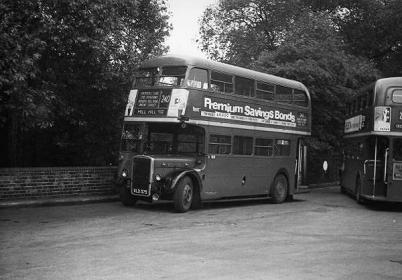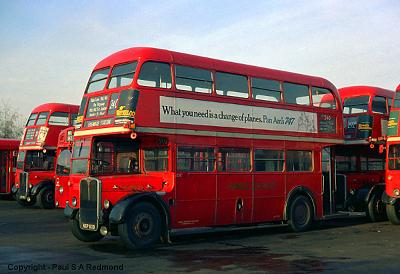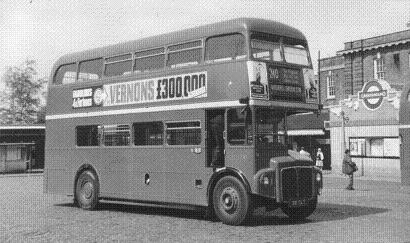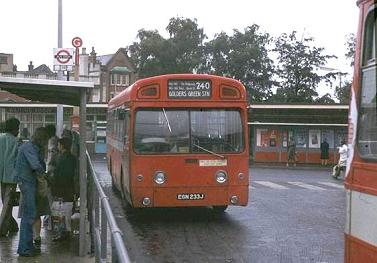The General’s route 104 was the first to
operate the new single-deck LT Scooter in 1931, when LT1001 was
delivered to Hendon (AE) and worked the route for three months,
before moving to Muswell Hill for the 111 (later the 212). Later deliveries for the route, later
that year, went to Edgware (EW) and Cricklewood (W).
 The
route worked in two sections before the second world war, the
full route between Edgware and Golders Green
being single-deck, due to the low railway bridge at Mill Hill,
and a double-deck section between Mill Hill East and Golders
Green.
The
route worked in two sections before the second world war, the
full route between Edgware and Golders Green
being single-deck, due to the low railway bridge at Mill Hill,
and a double-deck section between Mill Hill East and Golders
Green.
As primarily a single-deck route, the 104 was
renumbered 240 in October 1934, when it operated a fascinating mix
of buses – as well as the Scooters (including a Sunday allocation
from Holloway (J)), Cricklewood allocated one T and the single-deck
London Six LS6, with NSs for the double-deck section. These
ran alongside STs from Edgware but were replaced on Saturdays by
STLs from Chalk Farm (CF).
RTL1479 blinded for a journey to Mill Hill at
Cricklewood garage.
Photo © MikeBeamish
The outbreak of war saw the allocation
simplified, with just W providing LT Scooters and STLs. A
diversion via Sanders Way in Mill Hill East was introduced in 1940,
meaning the route no longer served the station, which had closed in
1939.
 Edgware Garage forecourt, and RT3802 stands among other
RTs, still in a majority in late 1970, with a couple of SMSs.
Edgware Garage forecourt, and RT3802 stands among other
RTs, still in a majority in late 1970, with a couple of SMSs.
Photo
© Paul Redmond
Mill Hill East station opened in 1867, on the
GNR line from Finsbury Park to Edgware
via Highgate. This line became part of the pre-war Northern
Heights project, under which the Northern Line would be extended
beyond Highgate (the station now known as Archway) over existing
steam-operated rail lines. The line from Finsbury Park had
branches to High Barnet and Alexandra Palace, and the plans also
envisaged an extension north of Edgware to Bushey Heath.
Steam services ceased in 1939 and were replaced by rail-replacement
buses from Finchley Central to Edgware.
The war meant that the Northern Heights
project was never completed. The extension from Archway to
High Barnet opened in 1940, and to serve the Mill Hill Barracks the
branch to Mill Hill East was electrified and opened, still as a
single track, in 1941 – the last element in today’s Northern
Line. The Alexandra Park branch, which passed under Muswell
Hill by a weak bridge that forced London Transport to work the busy
212 with single-deckers, continued to
operate a shuttle from Finsbury Park until 1954, but the section
between Mill Hill East and Edgware never reopened to passenger
traffic and closed completely in 1964. Despite considerable
work, including the building of the depot (which later became LT’s
Aldenham Works), the extension north of Edgware was never
built.
Catch Jay Foreman's video commentary on the
Northern Heights project here. Five
points for spying the King Crimson snippet.
 Cricklewood's
RM1381 stands on the cobbles at Golders Green Bus Station. It
is likely that this is 1970, as it was only in the last 6 months
before OMO conversion that Cricklewood had an official RM
allocation on the 240, on Sundays only.
Cricklewood's
RM1381 stands on the cobbles at Golders Green Bus Station. It
is likely that this is 1970, as it was only in the last 6 months
before OMO conversion that Cricklewood had an official RM
allocation on the 240, on Sundays only.
Photo Ian Armstrong collection
Returning to the 240, later in 1940 the
single-deck section was shortened to run only to Mill Hill
Hendon Way, and the allocation for this section moved back
to EW. When Mill Hill East station reopened in May 1941, the
single-deck section was extended to terminate there, thus diverging
slightly from the double-deck section; the double-deck service
resumed its former route in 1944. From 1945, this single-deck
extension became peak-hours only.
From being largely open country in 1930, the
area around Mill Hill was now becoming built up and new roads
required new services. In consequence, part of the 240’s
single-deck service was extended (using the same Scooters from EW)
to Page Street, at the end of Bunns Lane, as new weekday route
240A. In 1951, the 240’s single-deck section was
withdrawn completely and the 240A was extended daily
over the new Bittacy Rise and Pursley Road to Mill Hill East
station.
Cricklewood had replaced its STLs with RTs in
1948, Edgware replaced its Scooters by TDs in 1949. The Mill
Hill to Golders Green service continued until 1966, with the Sunday
allocation moving from W to AE in 1959. AE worked RTs on that
day until replacing them with RMs in 1962; W switched from RTs to
RTLs in 1963. The Saturday allocation also moved to AE in
1965, but this was RT operated.
 In
January 1966, one consequence of building the M1 through Mill Hill
was the lowering of the road under the railway to permit
double-deck operation. This spelled the end of the
240A on weekdays and its replacement by an extension of
the 221 from Finchley via Mill Hill East to Edgware, together with
the extension of the 240 to Edgware. On Sundays, the
240A continued in operation, now by RTs, and was
extended to Golders Green and covering half of the 240
workings.
In
January 1966, one consequence of building the M1 through Mill Hill
was the lowering of the road under the railway to permit
double-deck operation. This spelled the end of the
240A on weekdays and its replacement by an extension of
the 221 from Finchley via Mill Hill East to Edgware, together with
the extension of the 240 to Edgware. On Sundays, the
240A continued in operation, now by RTs, and was
extended to Golders Green and covering half of the 240
workings.
A week after the change, the 240 was a victim
of an overtime ban by bus staff. Cronshaw operated an
emergency weekday service between Mill Hill Broadway and Golders
Green Station until the 240 resumed in March. The combined
allocation from EW, W and AE continued until the route was
converted to one-man operation in 1971.
Cricklewood-based SMS233
stands at Golders Green, by now in the late 1970s resurfaced and
reorganised.
Photo Ian Armstrong
collection
OMO operation was by SMSs from EW and W, until
1980 when both garages converted to Metrobuses. AE made a
brief reappearance on Sundays in 1985 before the route was
allocated solely to EW the following year. 2003 saw the route
converted to low-floor double-deckers and the route continues to be
operated by Metroline from EW.